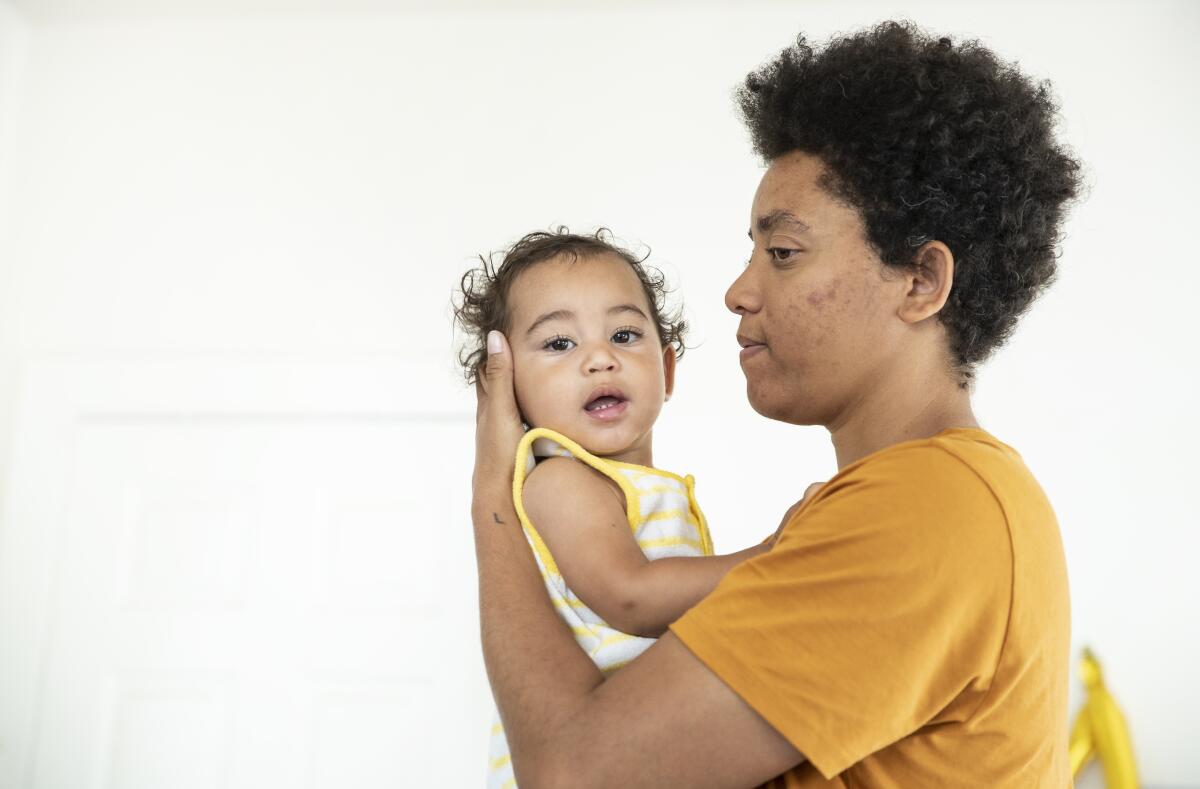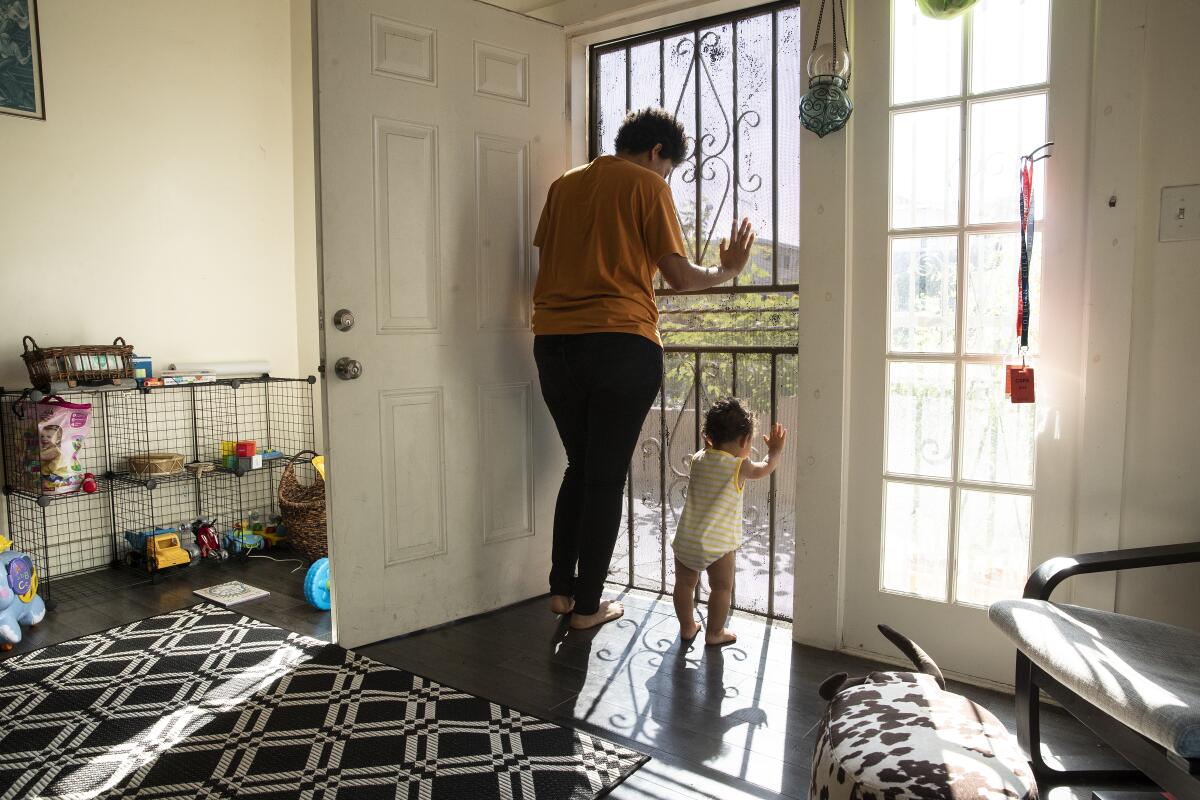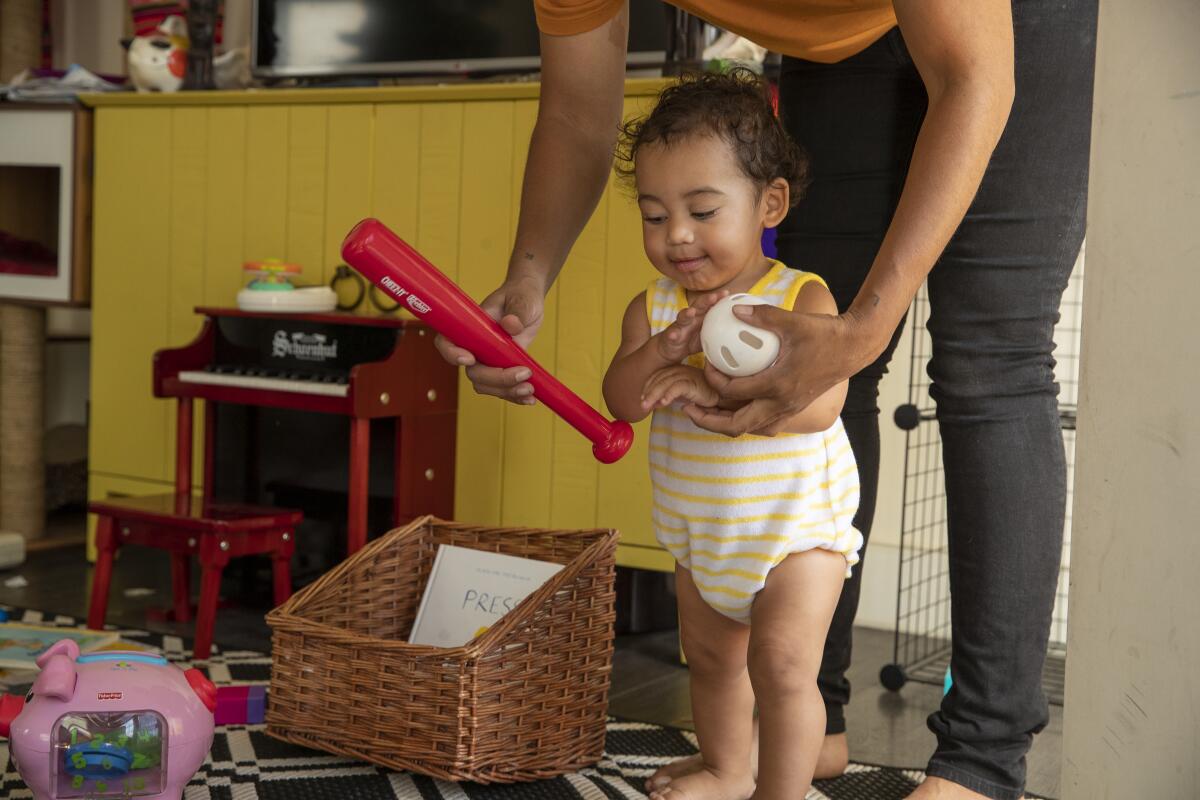These L.A. parents don’t want to assign a gender to their baby, so the government did it for them

- Share via
When Azul Ruelas-Brissette was born in the summer of 2018, the baby’s parents were resolute: They did not want “male” or “female” spelled out on their child’s birth certificate.
Jay Brissette and Miguel Ruelas had weighed their decision carefully. They are part of a small but burgeoning cohort of parents who are raising their children in what they call a “gender creative” or “gender expansive” way.
In the couple’s Los Angeles social network alone, several of their friends have chosen not to reveal the gender of their children until the kids are old enough to articulate their identities on their own.
The idea is that kids who spend the first few years of their lives without the stereotype-loaded labels of boy and girl will feel free to be their most authentic selves, whether they’re boys who like to play house or girls who like to play with chemistry sets.
Brissette, 35, who identifies as non-binary and uses “they,” “them” and “theirs” pronouns, remembers the pressure to be a certain kind of person from a young age. Girls didn’t like to run around at recess; they liked to sit and talk and clap to “Miss Mary Mack.” This made it hard for Brissette, a tomboy, to fit in.
Brissette pointed out that these sorts of gender-coded expectations are constantly imposed on kids — and sometimes by kids — in ways both subtle and overt. “I don’t want that for this person,” Brissette said one recent day during an interview in their Westlake living room, while Azul sat on the carpet intently arranging neon blocks.
At home, Azul is exposed to books and TV programs that showcase a diverse range of identities. Azul wears clothing designed for both boys and girls. And Azul is called by feminine, masculine and gender-neutral pronouns so they can figure out what feels best to them.
To Brissette, gender-creative parenting does not mean “gender neutral,” they emphasized, nor does it mean assigning a non-binary identity to Azul. It is not about encouraging Azul to be transgender or gay or contrarian. It’s about giving Azul the foundation to think critically about how the dynamics of gender play out in society, and the freedom to figure out who they are without being told who they should be based on their biological sex.
Hence Azul’s birth certificate, which shows two dashes where gender is typically indicated. In January 2018, the state of California began issuing birth certificates that mark a gender of female, male, non-binary (those whose gender identities fall outside the categories of male or female) or nothing at all. At least 10 other states allow gender-neutral markers on identity documents.
But Brissette and Ruelas soon learned that federal agencies still adhere to traditional ways of designating gender.
Last November, the couple contacted the Social Security Administration to inquire about registering Azul for a Social Security number. They asked how they should handle the application form, which has just two options in the “sex” category: male and female.
“They went into this whole thing. That we had to pick a gender, that a baby is not a person without a gender,” Brissette said.
The SSA declined to answer questions specific to Azul’s case. In a statement to The Times, the agency reiterated its policy but did not explain why it exists.
“I don’t see how we can accept that the government told us who our baby is without giving us a satisfactory reason,” Brissette said.

The way the couple’s request was handled is emblematic of a larger issue. Many state and federal government agencies still do not allow non-binary, genderqueer — meaning a person who does not identify as a man or woman, but as neither or somewhere in between — and intersex people to affirm their gender through identity documents, or have set high barriers for doing so.
Most states now let residents change gender markers on driver’s licenses and birth certificates from “male” to “female,” and vice versa, though some have more burdensome processes than others. At least 15 states require proof of gender confirmation surgery in order to amend gender markers on birth certificates, while Tennessee, Kansas and Ohio do not allow such changes to be made at all.
At the federal level, the Department of State allows gender-marker changes on passports for both adults and children who submit proof of clinical treatment, which could mean hormone therapy, surgery or psychotherapy. The Social Security Administration has a similar policy, but also will authorize an adjustment if applicants can show another government-issued document reflecting the change.
But as it stands, U.S. passports do not have a non-binary or gender-neutral option. And as Brissette and Ruelas found out, neither does the Social Security Administration.
Although Social Security cards do not have gender markers, the SSA keeps computer records for everyone who has a Social Security number, including name, date of birth and gender, according to the National Center for Transgender Equality. This information is used mostly for statistical and research purposes, but some state government agency systems still match gender against SSA records.
Azul’s parents didn’t want to capitulate to the policy.
So they contacted the Oakland-based Transgender Law Center, which helps transgender and gender-nonconforming people navigate the various gender-marker policies across the U.S. They were connected with a partnering organization, National Center for Transgender Equality, and were told that though advocates are trying to work with the Social Security Administration on this issue, it could be a long time before the agency’s policy on gender markers changes.
The reason lies in partisan politics.
The California bill that allows residents to obtain gender-neutral birth certificates was the first of its kind when it was signed into law by Gov. Jerry Brown in October 2017. “Gender identification is fundamentally personal,” the bill reads, “and the state should endeavor to provide options on state-issued identification documents that recognize a person’s accurate gender identification.”
There was some pushback. One conservative group argued that the new law, which eliminates the need for a doctor’s letter in support of a gender transition, could lead to identity fraud. There were also those who “fundamentally do not believe that LGBTQ people should have these rights,” said Alice Kessler, legislative director for Equality California.
But the will in California to support transgender and non-binary residents was ultimately stronger than those dissenting forces, Kessler said.
“Governments are here to serve the people, and people’s needs evolve,” she added. “The government should also evolve to meet those needs.”
Implementing such progressive policies in red states and on the federal level is much more challenging. Equality California hopes to one day help advance federal legislation modeled after gender-marker laws in the Golden State. But given that the Trump administration has many times over sought to curtail the rights of LGBTQ people, the organization says it will have to hold off until Democrats control both houses of Congress and the executive branch.
Brissette and Ruelas couldn’t wait that long.
Because Ruelas is a transgender man, the couple couldn’t biologically have a child together, and bringing Azul into the world was expensive. Each sperm sample from the California Cryobank cost $1,000 — they tried five times before Brissette got pregnant — and then there were the many doctor’s visits.
They were counting on a tax return to make ends meet. But Azul needed a Social Security card so that they could claim the baby as a dependent.
So they went to the SSA office in downtown L.A. with Azul, who wore a jean jacket and sparkly boots. They filled out the paperwork but left the “sex” category blank, and showed an employee Azul’s birth certificate.
A few minutes later, the employee handed the parents Azul’s Social Security card and a copy of the paperwork. On it, Azul was listed as male. The couple asked how, and why, the agency made that choice for them.
“They told us Azul did have a gender and closed the window,” Brissette said.
Gillian Branstetter, a representative for the National Center for Transgender Equality, said that the organization is “working with this family to try to resolve this issue.” The organization is reluctant to share its strategy because doing so could interfere with an already delicate process, she said.
“The federal government should respect a family’s right to decide how their child is raised, how their child is viewed in the world, how their information is shared,” Branstetter said.
Having consistent gender markers across documents is also a matter of safety and moving through life with greater ease. In the case of Social Security records, an application for disability benefits could be flagged if a state-issued ID does not match federal records, potentially stalling the process, according to Sasha Buchert, a senior attorney with Lambda Legal.
Those with passports whose gender markers conflict with their state IDs or their gender presentation are also at risk.
“I’ve heard of people who’ve been traveling and have changed their state-issued ID, who can’t also get a non-binary marker on their passport,” Buchert said, “and they’ve been placed under additional scrutiny by the [Transportation Security Administration.]”
According to a 2015 analysis by the National Center for Transgender Equality, roughly one-third of respondents reported being “verbally harassed, denied benefits or service, asked to leave, or assaulted” after showing an ID with a name or gender that did not match their presentation.
The fight for access to accurate gender markers comes at a time when non-binary identities are increasingly visible and accepted. More than one-third of transgender or non-gender conforming people identify as non-binary or genderqueer, according to the National Center for Transgender Equality survey. And a 2015 Fusion Millennial poll of American adults ages 18 to 34 found that half of the respondents see gender as a spectrum rather than a binary.
Yet the fight drags on.
In 2015, Lambda Legal filed a lawsuit against the State Department for denying intersex and non-binary activist Dana Zzyym a passport that accurately reflected their gender. The federal agency argued that they could not provide Zzyym with a passport labeling their gender as “X” because integrating such a change into its software system would “take approximately 24 months and cost $11 million.”
Nine states, including California, countered in an amicus brief that adding an “X” marker to driver’s licenses and other documents has “proven neither complex or disruptive.”
In September 2018, the U.S. District Court for the District of Colorado decided — for the second time — that officials cannot deny a passport application based only on a person’s refusal to select male or female as their gender. U.S. District Judge R. Brooke Jackson called the State Department’s reasons for rejecting Zzyym’s application “arbitrary and capricious.”
But the State Department has continued to resist the decision, and Zzyym still doesn’t have their passport. Even so, advocates are hopeful that the case will pave the way for expanded gender choices on federal identification.
Among the chorus of voices demanding such choices are parents like Brissette and Ruelas. They do not want baby Azul to be saddled “with stuff they have to undo later,” Brissette said, whether that means a narrow understanding of what it means to be a man or a woman or a gender marker that doesn’t match their identity.
Campbell Leaper, a psychology professor at UC Santa Cruz who studies childhood gender development, said that gender stereotypes limit kids early and enduringly.
“When you’re put in a category right away, that guides so much of how you’re going to be treated and what opportunities you’ll be given,” Leaper said.
Brissette and Ruelas are both well-acquainted with the limiting and sometimes harmful nature of those categories.
Brissette remembers being approached by a committee of female classmates in the second grade. The leader of the pack informed Brissette that they had too much hair on their legs, and gave them two options: to shave or wear pants all year.
One girl gave 7-year-old Brissette a razor. At home, Brissette waited for everyone to leave, and then dry shaved their legs in the living room. The cuts burned for days.
“I remember clearly thinking, ‘This can’t be right. Why does anyone have to do this to be a girl?’” Brissette said.
Ruelas, a transgender man who began to transition from female to male when he was 20, was profoundly affected by traditional gender roles growing up. Beyond the painful process of grappling with his gender identity as a teen, his father didn’t support him going to college because he was a girl, he said. He was expected to stay home and take care of his parents. Meanwhile, Ruelas’ parents financially supported his brothers while they got their degrees.
But Ruelas still had to adjust to the concept of gender-creative parenting.
“I had longtime dreams of having a kid and having a certain kind of relationship with my son or daughter,” Ruelas said. “Then I realized that all those ideas were about me, not my kid. This is about wanting Zu to have their own life and be their own person.”
Brissette’s own experiences working with children played a major role in convincing the couple that there was a more thoughtful way to raise them.
A few years ago, Brissette helped run an after-school program for elementary school students who needed extra academic support. The kids, ages 8 to 11, had a lot of questions about gender and sexuality after fliers concerning California schools being safe spaces for LGBTQ students were posted in the hallways.
Brissette kept an anonymous question box out for the kids, and would sift through the paper slips and address them at the start of class. “Is a boy gay if he likes to dance?” one asked. A girl wrote that she didn’t like to wear dresses to church because they weren’t comfortable to run around and play in afterward.
One boy told the class that sometimes he’d get really upset but felt like he couldn’t cry.
“I just don’t want to set this person up to be either emotionally stunted as a boy or physically limited as a girl,” Brissette said of Azul.

Children typically self-identify their gender by age 2 or 3, according to research conducted by Leaper and other social scientists. This holds true for kids raised without an assigned gender, and most of those kids will self-categorize themselves in terms of biological gender, Leaper said. So the concern that gender-creative parenting will confuse a child, he said, is probably unfounded.
Brissette acknowledged that Azul might stand out in some settings, and standing out can attract cruelty and criticism. But at the end of the day, Brissette said, they want Azul to be able to advocate for themselves, and for other kids who may not have the words for it.
Azul’s parents are trying to lead by example. Standing up to the federal government, they believe, is a good start.
More to Read
Sign up for Essential California
The most important California stories and recommendations in your inbox every morning.
You may occasionally receive promotional content from the Los Angeles Times.











